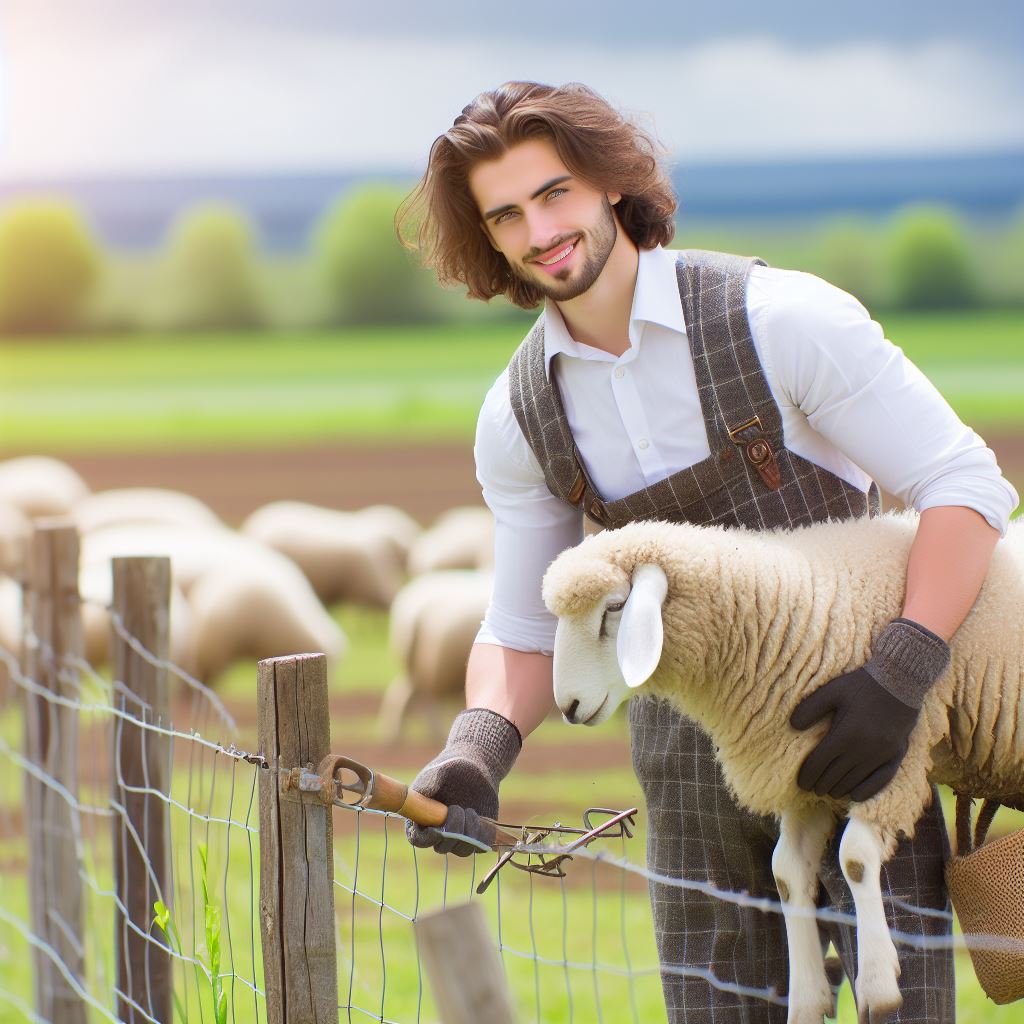Introduction
Fencing fields play a crucial role in sheep farming, ensuring the safety and containment of our beloved flock.
“Step into the world of ‘Fencing Fields: A Sheep Farmer’s Diary’ and immerse yourself in the rich tapestry of rural life.
This captivating diary not only unveils the daily triumphs and tribulations of a dedicated shepherd but also paints a vivid portrait of the bucolic landscapes they call home.
From the sun-kissed meadows to the starlit nights, each page resonates with the sounds of bleating sheep, the rustle of leaves, and the palpable connection between the farmer and their flock.
This blog post provides valuable insights from a sheep farmer’s perspective.
Through poetic prose and insightful reflections, the diary transcends the ordinary, inviting readers to witness the timeless dance between humanity and nature.
Join the shepherd on this literary expedition, where the simple act of fencing fields becomes a profound expression of love for the land, the animals, and the enduring rhythm of agricultural life.”
Understanding the needs of sheep
In order to properly care for and manage a flock of sheep, it is crucial to understand their unique needs and behaviors.
It is important for sheep farmers to be aware of the natural tendencies of these animals, as well as the potential risks associated with not meeting their needs adequately.
The natural behavior of sheep and their tendency to roam
Sheep are naturally social animals and have a strong flocking instinct.
They prefer to stay together and follow the lead of a dominant member within the group.
This behavior has evolved as a survival mechanism in the wild, where sticking together provides protection against predators.
However, despite their inclination to stay close to the flock, sheep also have a tendency to roam and explore their surroundings.
This behavior is not only driven by curiosity but also influenced by environmental factors such as the availability of food, water, or shelter.
It is essential for sheep farmers to understand that even though they might find a lush pasture with ample resources, the sheep may still be inclined to wander off if they are not effectively contained within appropriate fencing.
Transform Your Agribusiness
Unlock your farm's potential with expert advice tailored to your needs. Get actionable steps that drive real results.
Get StartedWhy proper fencing is essential to prevent sheep from escaping or wandering onto neighboring properties
Proper fencing is of utmost importance when it comes to managing and containing a flock of sheep.
The primary reason for having suitable fencing is to prevent the sheep from escaping or straying onto neighboring properties.
Sheep, being naturally curious, may try to explore the unfamiliar territory beyond their boundaries.
This can lead to various problems not only for the farmer but also for the sheep themselves.
Often, neighboring properties may be subjected to different land uses and may not offer suitable conditions for sheep to graze or stay safe.
Allowing sheep to wander onto neighboring properties can result in conflicts with other landowners, damage to crops or gardens, or disturbances to wildlife habitats.
Additionally, sheep may encounter potential dangers such as busy roads, where accidents can occur, or areas where predators may pose a threat to their safety.
It becomes essential for sheep farmers to establish strong and secure fencing systems to ensure that their sheep remain within their intended boundaries.
The risks associated with sheep straying, such as predator attacks or road accidents
When sheep stray beyond their designated areas due to inadequate or improper fencing, they become susceptible to various risks and threats.
Predator attacks are one of the primary concerns when sheep wander away from their flock.
Wolves, coyotes, and other predatory animals perceive these isolated sheep as easy targets.
These attacks can result in injury or death for the sheep, which can be a significant loss for the farmer.
When sheep venture onto busy roads, they are at a heightened risk of being involved in accidents.
They may not understand the traffic patterns and are vulnerable to being hit by passing vehicles.
These accidents can cause severe injuries to the sheep or even lead to fatalities.
Moreover, straying sheep may cause damage to neighboring properties, including gardens, crops, or ornamental plants, resulting in financial losses and conflicts with other landowners.
By prioritizing proper fencing practices, sheep farmers can significantly mitigate these risks and ensure the safety and well-being of their flock.
Read: Soil and Sweat: The Reality of Farming
Choosing the right fencing materials
Choosing the right fencing materials is crucial for successful sheep farming.
Various fencing options available for sheep farming, including traditional fences, electric fences, and netting
There are various options available, including traditional fences, electric fences, and netting.
Traditional Fences
- Wooden fences are a popular choice due to their durability and aesthetic appeal. They can be expensive to install but require minimal maintenance.
- Barbed wire fences are cost-effective and provide good security, but they may cause injury to the sheep if not properly maintained.
- Woven wire fences are strong and versatile, making them suitable for different farm layouts. They offer excellent protection against predators.
- High-tensile electric fences combine the advantages of electric and traditional fences. They are durable, low-maintenance, and highly effective in containing sheep.
Electric Fences
- Electric fences are an efficient option for sheep farmers as they can be easily installed and provide a psychological barrier for the sheep.
- Temporary electric fences are portable and ideal for rotational grazing systems. They allow flexibility in managing pasture and conserving forage.
- Permanent electric fences require a more substantial investment but provide reliable, long-term protection against predators.
- Electric netting is also available and offers a higher level of security, especially against smaller predators such as foxes.
Netting
- Woven wire netting is a popular choice as it effectively keeps sheep contained and predators out. However, it can be expensive and time-consuming to install.
- Electric netting, as mentioned earlier, is a viable alternative for added security against small predators.
- Netting made of polypropylene or high-density polyethylene is lightweight and easy to install. It is suitable for temporary fencing or exclusion zones.
- Mesh wire netting is another option, providing good visibility and airflow while ensuring sheep stay within their designated areas.
The pros and cons of each type of fencing material
Each type of fencing material has its own set of pros and cons, and the choice depends on several factors:
- Available budget: Sheep farmers with limited resources may opt for cost-effective solutions like barbed wire or electric fences.
- Predator pressure: Areas with a high concentration of predators may require stronger fencing options such as electric netting or woven wire.
- Farm layout: The shape and size of the farm will determine the feasibility of different fencing materials and installation methods.
- Personal preferences: Some farmers prioritize aesthetics and may choose wooden fences, while others focus on functionality and security.
Recommendations based on the specific needs and resources of the sheep farmer
Based on the specific needs and resources of the sheep farmer, the following recommendations can be made:
- For a limited budget, combining barbed wire and electric fences can provide adequate sheep containment and predator deterrence.
- Sheep farmers dealing with high predator pressure should consider investing in electric netting or woven wire fences with additional security features.
- In rotational grazing systems, portable electric fences are a practical choice for managing pasture efficiently.
- Those with larger farms and more resources can opt for aesthetically pleasing wooden fences while ensuring durability and maintenance.
In brief, choosing the right fencing materials is essential for every sheep farmer.
Assessing specific needs, available resources, and considering the pros and cons of each option will lead to an informed decision that ensures the safety and containment of the sheep.
Showcase Your Farming Business
Publish your professional farming services profile on our blog for a one-time fee of $200 and reach a dedicated audience of farmers and agribusiness owners.
Publish Your ProfileRead: Barns and Bonds: Community Farming
Planning the Fence Layout
Planning the layout of the fencing on our farm is a crucial step in ensuring the safety and well-being of our sheep.
There are several factors to consider when designing the fence layout, including the size and topography of the field, proximity to other properties, and the number of sheep we have.
Factors to Consider
- Size and Topography: The first step in planning the fence layout is assessing the size and topography of the field. We need to determine the dimensions and shape of the area to be fenced and take into account any hills, slopes, or uneven terrain.
- Proximity to Other Properties: Another important factor to consider is the proximity of our field to other properties. We want to ensure that our fencing is set back a suitable distance from neighboring houses or roads to prevent any potential conflicts and allow for easy maintenance.
- Number of Sheep: The number of sheep we have also plays a significant role in determining the fence layout. Larger flocks may require more extensive fencing or the creation of separate enclosures for rotational grazing.
The Importance of Proper Gate Placement
One aspect that cannot be overlooked when planning the fence layout is the placement of gates.
Proper gate placement is crucial for easy access and movement of the sheep.
Here are some key considerations:
- Accessibility: Gates should be strategically placed to allow convenient access to different areas of the field, such as feeding stations or watering points. This reduces the time and effort required to reach these locations.
- Flow and Movement: Gates should be positioned to facilitate the smooth flow and movement of the sheep. It’s important to consider the natural patterns of the sheep’s behavior, such as their tendency to move in herds or follow specific paths.
- Safety: Gates should be designed to ensure the safety of both the sheep and the farmer. Sturdy and well-maintained gates prevent escape and keep predators at bay while allowing for easy handling and sorting of the animals.
- Multiple Gate Placement: Depending on the size and shape of the field, multiple gates may be necessary to create efficient grazing rotations or separate areas for different purposes, such as lambing or medical treatments.
In essence, when planning the fence layout for our sheep farm, we must carefully consider the size and topography of the field, proximity to other properties, and the number of sheep.
Additionally, proper gate placement is essential to ensure easy access and movement of the sheep.
By taking these factors into account, we can create a safe and functional fencing system that meets the needs of our flock.
Read: Tilling Tales: A Family Farm History

Building and maintaining the fence
Building and maintaining the fence is crucial for a sheep farmer.
A sturdy fence ensures the safety and well-being of the flock by keeping them contained and protected from predators.
It also helps to establish boundaries and prevent sheep from straying onto neighboring properties.
Provide a step-by-step guide on how to build a sheep fence
Here is a step-by-step guide on how to build a sheep fence:
Plan and Prepare
- Assess the area where the fence will be built and mark the boundaries.
- Obtain necessary permits and check local regulations regarding fence construction.
- Gather all the required tools and materials, including fence posts, wire mesh, gate hardware, and tools like a post hole digger and wire cutters.
Digging Post Holes
- Start at one corner and dig the first post hole using a post hole digger.
- Ensure the hole is deep enough to accommodate one-third of the post’s length.
- Space the holes according to the recommended distance, typically 8 to 12 feet apart.
Installing Fence Posts
- Place a post in the first hole and fill it with soil, ensuring it is firm and secure.
- Use a level to ensure the post is plumb and aligned correctly.
- Repeat this process for each post, making sure they are evenly spaced and aligned.
Attaching Wire Mesh
- Unroll the wire mesh along the fence line, starting from one corner.
- Attach one end of the mesh to the first post using fence staples or wire ties.
- Straighten the mesh and attach it to the remaining posts, ensuring it is pulled tightly.
Securing Bottom Line
- Bury the bottom edge of the wire mesh into the ground to prevent sheep from squeezing underneath.
- Use stakes or rocks to hold it in place securely.
- Check the stability and adjust as needed.
The importance of using quality materials and ensuring sturdy construction
Using quality materials and ensuring sturdy construction is essential to maintain a durable fence:
- Invest in high-quality fence posts that are rot-resistant, such as pressure-treated wood or steel.
- Choose a strong and durable wire mesh specifically designed for sheep fencing.
- Use sturdy gate hardware and hinges that can withstand repeated opening and closing.
Regular maintenance and repairs are necessary to prolong the lifespan of the fence:
- Inspect the fence regularly, looking for any damage or weakened areas.
- Repair any loose wires, broken posts, or damaged mesh promptly.
- Remove any vegetation or debris that may accumulate around the fence, as it can harbor pests or cause damage.
Tips for regular maintenance and repairs to prolong the lifespan of the fence
Tips for regular maintenance and repairs:
- Use a wire tensioner tool to keep the wire tight and prevent sagging.
- Apply a protective coating or paint to wooden posts to prevent rotting and extend their lifespan.
- Keep surrounding vegetation trimmed to prevent it from leaning on or damaging the fence.
- Consider adding electric wires or deterrents to keep predators away from the fence.
Building and maintaining a fence is an ongoing task that requires attention and care.
By following these steps and utilizing quality materials, a sheep farmer can ensure a secure and long-lasting fence, providing safety and security for their flock.
Regular maintenance and repairs further contribute to the fence’s longevity, ultimately safeguarding the farmer’s investment and the sheep’s well-being.
Read: Fields of Green: A Young Farmer Tale
Troubleshooting common fencing issues
Identifying common challenges and problems for sheep farmers
Fences are essential for keeping sheep safe and secure on the farm.
However, they can present various challenges and problems for sheep farmers.
Understanding and troubleshooting these issues is crucial for maintaining the integrity of the fencing system and ensuring the safety of the flock.
Fence damage
Sheep can be quite mischievous and love to push or lean against fences, causing damage over time.
Common issues include bent or broken wires, loose posts, and sagging sections.
Solution
Regularly inspect fences for damage and promptly repair any issues.
Replace broken wires or damaged posts and tighten any loose components. Reinforcing weak sections with additional support can also prevent further damage.
Escape routes
Sheep are notorious escape artists and can find the tiniest gap or hole to squeeze through, leading to potential danger or loss.
Common escape routes include spaces under gates, damaged panels, or poorly secured fencing materials.
Solution
Regularly check the perimeter for any potential escape routes.
Repair or reinforce any weak spots and ensure gates and panels are secure.
Installing electrified wires or mesh at the bottom of the fence can also deter sheep from attempting to escape.
Animals damaging the fence
Aside from sheep, other animals such as predators or curious livestock can cause damage to fences.
This can include digging under fences, rubbing against them, or even chewing on the wires.
Solution
Identify the culprits causing damage and take appropriate actions, such as reinforcing the fence with predator-proof mesh or installing deterrents.
Regularly monitor the fence perimeter and address any signs of damage promptly.
Providing advice on preventive measures
While troubleshooting existing fencing issues is vital, preventing these problems from occurring in the first place can save time, effort, and resources.
Implementing preventive measures can help minimize the likelihood of encountering fencing challenges.
- Regular maintenance: Conduct routine inspections of the entire fencing system. Look for signs of wear and tear, loose wires or posts, and any potential weaknesses.
Fixing minor issues before they escalate can prevent major problems. - Invest in quality materials: Using durable and sturdy fencing materials can significantly reduce the risk of damage. Choose high-quality wires, robust posts, and reliable gates.
Investing in superior materials upfront can save money in the long run. - Proper installation: Improperly installed fences are more prone to issues. Ensure that the posts are firmly anchored, wires are correctly tensioned, and gates are securely attached.
Follow manufacturer guidelines for proper installation techniques. - Clear vegetation: Overgrown vegetation along the fence line can create opportunities for damage. Regularly trim plants and remove any brush that may come in contact with the fence.
This also helps with visibility and predator deterrent. - Educate the flock: Teaching the sheep to respect the fence can go a long way in preventing damage. Gradually introduce them to the fencing system and use positive reinforcement to discourage them from pushing or leaning against the fence.
In review, understanding common fencing challenges and troubleshooting techniques is essential for sheep farmers.
Showcase Your Farming Business
Publish your professional farming services profile on our blog for a one-time fee of $200 and reach a dedicated audience of farmers and agribusiness owners.
Publish Your ProfilePromptly addressing fence damage, identifying escape routes, and protecting the fence from damage-causing animals are crucial for maintaining flock safety.
By implementing preventive measures, including regular maintenance, investing in quality materials, and proper installation, sheep farmers can minimize fencing problems and ensure the longevity and security of their fencing systems.
Conclusion
Proper fencing is of utmost importance in sheep farming.
It plays a crucial role in ensuring the safety and well-being of the sheep.
Throughout this diary, we have seen how a well-maintained and functional fence can prevent predators from harming the sheep and keep the animals within the designated boundaries.
It is essential for every sheep farmer to prioritize fencing as it directly impacts the overall success of the operation.
Neglecting the fence can lead to disastrous consequences, including the loss of valuable livestock.
By investing in the right materials, regularly inspecting and maintaining the fence, and using reliable construction techniques, farmers can create a secure environment for their sheep.
We also encourage readers to share their own experiences or tips related to fencing in the comments section.
This collaborative effort allows us to learn from each other and further improve our sheep farming practices.
Proper fencing is not an option but a necessity for every sheep farmer.
It is the foundation of a successful and thriving operation, ensuring the safety and well-being of the flock.




